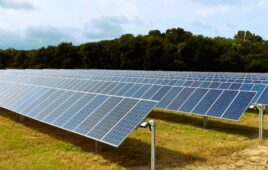By Larsh Johnson, CTO of Stem
The U.S. solar revolution has been a terrific boon to customer choice, the economy and climate policy planning. But solar panels alone can’t achieve the full value of solar generation or the aggressive goals of greenhouse gas reductions. Moreover, solar developers face a wave of changes that is challenging their continued growth. Energy markets are shifting, supply chains are becoming more competitive, electric and solar rates are changing and customers’ interest in controlling their energy destiny is increasing. As a result, the economics of distributed solar projects are getting skinnier and riskier for the solar developer.
The falling costs of energy storage can give developers and customers the flexibility to deal with all those changes and further grow their business. But here’s the thing — battery hardware alone does little to unlock the true value of energy storage. The fundamental key to unlocking that value is intelligent software, in the form of artificial intelligence (AI). Pairing solar with AI-driven storage is the gamechanger that differentiates solar projects going forward.
Commercial and industrial demand for “standalone” energy storage is booming in U.S. and international markets because it automatically reduces electricity costs through demand charges with no impact on operations. Intelligent storage can also deliver other services, or “value stack” additional contracted revenue. For example, unused energy stored in a network of batteries can be delivered as a virtually-integrated resource to those grid locations that need power. So if a certain area of the grid is experiencing high demand and straining the grid, a network of available energy can be mobilized by AI-enabled software to meet that demand. The result is additional revenue for the customer, along with the energy-bill-saving benefits of storage.
As new incentives and value streams emerge, it becomes increasingly complex to maximize returns while ensuring program compliance. So complex, in fact, that realizing the full value of solar+storage is only possible with artificial intelligence. AI-based controls enable energy storage to deliver a range of new value streams for solar projects, including reduced demand charges, increased revenue through virtual power plants, future-proofing against changing rates and more value captured from the investment tax credit.
Adding storage to a solar installation will almost always increase the economic value of a solar project, mostly by using the stored solar power during the customer’s peak. In order to size the system correctly and maximize the returns from a solar+storage system for the customer, AI is needed to perform the predictive analytics, machine learning, big data and grid-edge computing required to achieve these returns. Every second of data is captured on loads, solar generation, weather, nearby grid congestion and electricity rate, and in turn, AI drives real-time adaptive storage dispatch that generates increasing value for the customer and the grid.
Energy storage is quickly becoming the most revolutionary piece of the energy puzzle for customers, policymakers and the economy, but it is a fundamentally different tool than ever before. It’s a smartphone compared to a rotary phone. It can stand alone and produce multiple services for the customer, utility and the grid—even where solar economics do not pencil. Or it can be used to optimize distributed energy assets dramatically expanding the PV value, turning solar into a dispatchable grid-facing asset. Moreover, storage’s value in shaping and smoothing variable generation will enable the buildout of new solar systems beyond current grid tolerances.
In each of these cases, the customer, solar developer, ratepayer, utility and grid win. Adding storage to solar projects maximizes the return on the solar investment, gives the host site greater control and flexibility in the face of changing rates and enables access to new utility programs or wholesale market revenue opportunities. Utilities and grid operators can contract services from customer-sited solar virtual power plants to provide firm, reliable and cost-effective energy precisely where and when it’s needed, avoiding the need for new peaking power plants or other costly infrastructure.
AI-powered energy storage is enabling the rise of “intelligent” solar. Solar deployed with storage will soon dwarf the deployment of standalone solar. When we marry solar power with energy storage, we ensure solar is reaching its full potential—and that’s best for the solar industry and its customers.




Entering the newest computer model where power can be stored and relocated with a system that can switch and anticipate coverage or additional storage of electricity is game changing…